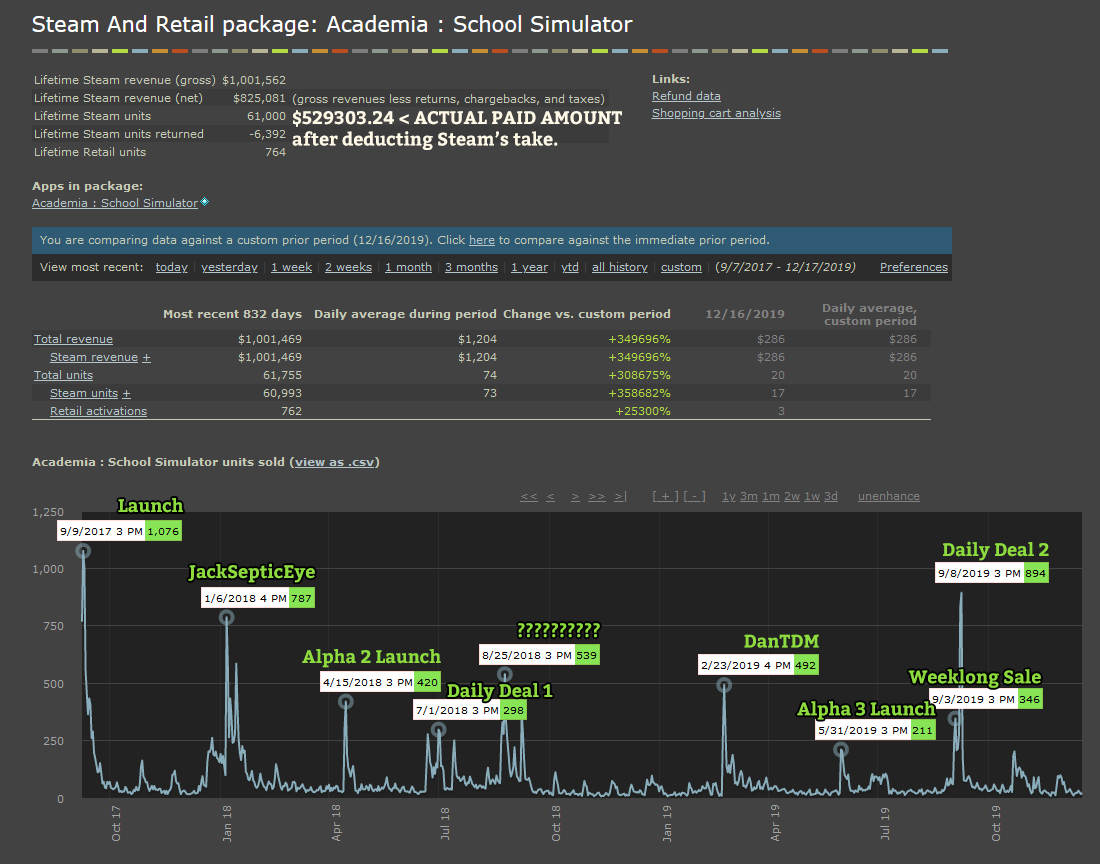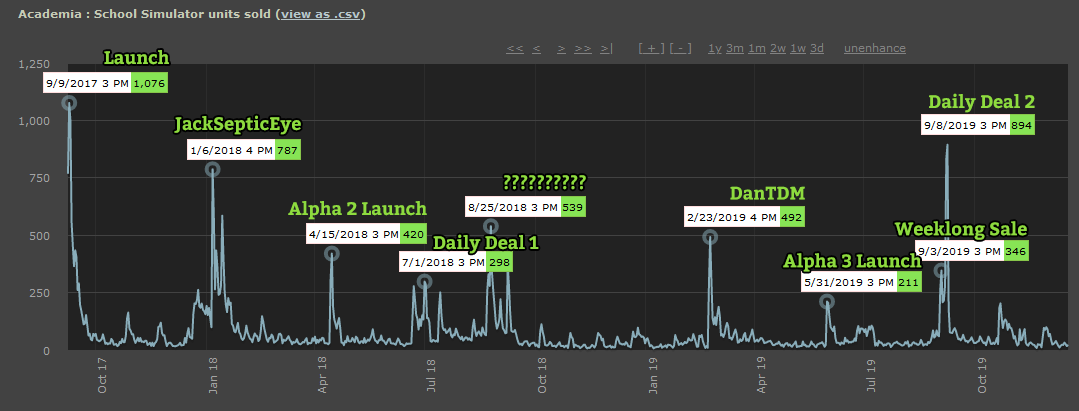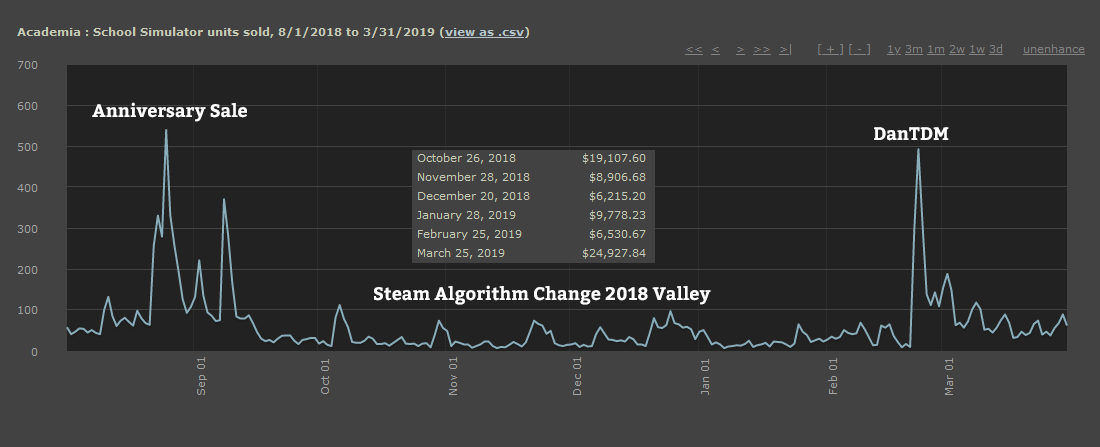Trending
Opinion: How will Project 2025 impact game developers?
The Heritage Foundation's manifesto for the possible next administration could do great harm to many, including large portions of the game development community.

Featured Blog | This community-written post highlights the best of what the game industry has to offer. Read more like it on the Game Developer Blogs or learn how to Submit Your Own Blog Post
So, we're back with a behind-the-scenes analysis of another Steam game's sales. Many thanks to Ryan Sumo for allowing us to check out lifetime revenues for Squeaky Wheel's Academia: School Simulator.

So, we’re back with a behind-the-scenes analysis of another Steam game’s sales.
After previous analyses looked at Golf Peaks and the games of Bad Logic Studios, many thanks to Ryan Sumo for allowing us to check out lifetime revenues for Squeaky Wheel’s Academia: School Simulator on Steam since its late 2017 launch (up to mid-December 2019).
Academia: School Simulator has a pretty good (in my view!) hook for a game: “Design, build, and manage a high school with terrific teachers and fantastic facilities or simply let your students poop in the bushes? Academia : School Simulator is a management/tycoon game where you get to decide!”
And as we can see, with a Steam gross over just over $1 million since Early Access launch (& the game has yet to have its ‘full Steam launch’), the title has been doing pretty well. This is especially true for a team with a lower monthly ‘burn rate’ based in the Philippines, as Squeaky Wheel is.

There’s a LOT to analyze in the above data-rich screenshot of the Steam back end. But before we do, Ryan has been very transparent with me (and us) about why him and his team are not wearing money hats, even after ‘making $1 million’.
As he annotated on the image above, $529,000 is the actual amount of money his company has received as of November 2019 - after refunds, VAT/other country-specific taxes, and Steam taking its 30% cut, plus a 15% U.S. withholding tax since Squeaky Wheel is headquartered in the Philippines.
So, yep - a general rule is 60% of your gross is your net for Steam sales, but including things like the U.S. withholding tax for certain countries, it can actually get closer to 50%, as shown here.
Ryan also notes: “Of that amount, 20% is given to parties who invested in the game (not the studio)” - leaving USD $423,000.
He continues: “That amount, should be divided across the amount of time it took us to earn it, so $423,000 / 26 (months) = $16,300. Of the $16,300, our monthly costs are $7,500, which supports 6 people along with miscellaneous office expenses (numbers rounded as we have added people over time). The monthly costs include Unity and other software licenses, accountant expenses, twice a month meetings and lunches at a coworking space, and cost of taxes and government services.”
Again, this related to the point I’ve been discussing about ‘you can make games from anywhere’. Six talented people and office expenses for that averaged amount of money is impressive, given that a single U.S. West Coast game company employee (without healthcare) might cost similarly to Ryan’s entire studio.
And here’s the capper: “That leaves us with $8,800 per month as actual profit on average [since launch]. We have set aside enough money to allow us to operate for a year, and have distributed the rest to team members in a profit sharing initiative. We've also invested some money in another local game called Ruinarch (wishlist now lol), because we are very keen on supporting the local gamedev community.” That is... very cool.
Actually, I’m just going to re-paste the sales graph part of the above image - so you can see it again - and we can discuss:

So, what am we seeing in here? Well, 1,000 copies of Academia sold on launch day is pretty decent (even bearing in mind that was back in 2017, when there were many less games launching!)
But I think what is more impressive is the longevity and spikes around the game - it looks like Early Access has suited it. Its particular ‘in-depth simulator’ genre and unique subject is working well for long tail sales.
At a low point, it looks like the game is still selling 10-20 copies per day. But the constantly updated content, some of the Alpha launches - and the REALLY BIG YouTuber features - have made a big difference. And then there’s the Daily Deal - if you’re high profile enough for Steam to give you one, it really helps!
(Anecdotally, there are only a few YouTubers (5-10) that give you such a boost that you’ll see it on sales for days or weeks - and JackSepticEye & DanTDM are two of those. No More Robots-published title Not Tonight got a video series from JackSepticEye which had a similar super-positive effect on sales just after launch.)
I’ll also note that Academia: School Simulator seems to be a fairly YouTube-friendly game in general. This is presumably because:
- it has ‘simulator’ in the title, which is a good nod to streamers that it might be fun/goofy.
- it’s based in a setting known to many YouTube/Twitch viewers - school, haha.
- its sandbox setup & multitude of options allows a lot of ‘design space’ for acting out shenanigans from performative streamers like JackSepticEye.
A lot of the time, I suspect that small or mid-sized YouTubers can contribute 1 or 2 sales a day via ‘discovery’. It’s just difficult to concretely track this. But those kind of numbers add up. Which is why having a broad range of streamers cover you is still great, even if none of them are superstars.
Next up, here’s three interesting wishlist-related graphs for Academia. First up, here’s the pre-release ‘wishlist additions’ per day - Ryan notes: “We were pretty shit at getting wishlists [before the game came out], with about 1,500 pre-launch.”

The ‘average’ wishlists to sales conversion, according to Jake Birkett’s surveys, would be sales in the first week averaging 58% of the game’s launch wishlists. But in Academia’s case, it only had 1,500 wishlists and still sold almost 1,100 copies in just the first DAY. So first week sales looks like it was at least 200% of the game’s launch wishlists.
That’s an impressive outlier. (But bear in mind this was in late 2017, not early 2020, and things have changed, especially in terms of number of games released on Steam. And also, I think Academia: School Simulator has a really good ‘hook’.)
Ryan adds, on this point: “I was very proactive in other aspects of marketing. For example we started video devlogs of the game within months of development. Sharing these on social media (and YouTube itself) attracted some attention, and by the time we released the Early Access trailer we had small to midsized YouTubers contacting us for keys. I was also very aggressively emailing anyone who had ever played a Prison Architect-type game and pitching the game to them.”
Next up, we have lifetime wishlists balance and wishlist additions for post-launch events:


Notable things to mention here - the (2017/2018 holiday sale and?) JackSepticEye effect on wishlists is actually in net larger than the launch effect. This shows what can happen if you get a hit from one of those Top 10 YouTubers. And Daily Deals are also surprisingly good for discovery.
Overall, this also compares to what I’ve seen with other games, in that wishlist purchases may be around 20-25% of your overall wishlist balance. So if you have a balance of 10,000 on your wishlist, very roughly 2,000 to 2,500 people have bought your game directly from your wishlist.
Of course, at least as many people again (and sometimes twice as many people!) have bought the game without using the wishlist function. In Academia’s case, 23,000 people bought the game after having wishlisted it, and another 38,000 just straight-out bought it.

Finally, Ryan kindly included this graph showcasing “the real effects of the Steam algorithm change of 2018.” It was definitely a significant issue for Squeaky Wheel’s game.
However, Ryan notes that the Steam algorithm changes in 2019 seem to have been more favorable to Academia. (And I think, from what I’ve heard, some other mid-sized successes also did decently from the most recent 2019 changes.)
Anyway, the point of this graph is not to say ‘X change was bad and Y change was good’ - because it’s different for different people.
It’s more just that Steam/Valve is constantly optimizing the store, and it can make algorithm and recommendation changes that impact your game at any time. So be somewhat - but not overwhelmingly - aware and responsive to this.
And… that’s it. Hope it helped your planning. Thanks so much to Ryan & his team for sharing this data. If you are a game dev who would like to do similarly, to this (or near this!) level of transparency, please ping me & we’ll sort something out.
[You’re reading the Game Discoverability Now! newsletter, a regular look at how people find - and buy - your video games. Or don’t. You may know me from helping to run GDC & the Independent Games Festival, and advising indie publisher No More Robots, or from my other newsletter Video Game Deep Cuts.]
Read more about:
Featured BlogsYou May Also Like